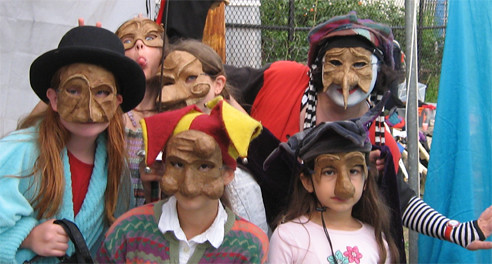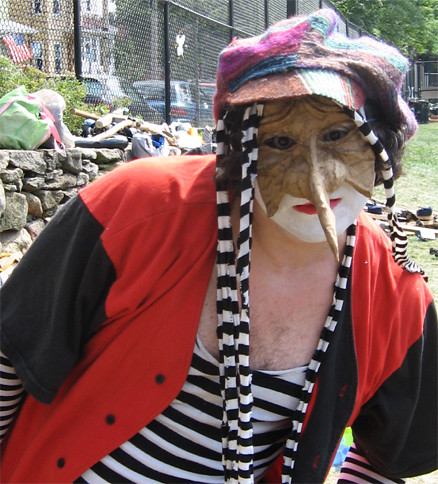
Click here for the full photo set
As I was preparing to teach another summer at Open Air Circus I thought back the past year's experience performing with i Sebastiani I lobbied to teach a class in commedia dell'arte as well as mime.
This quickly led to a problem, most of the children who gravitate to my classes have been girls, and traditionally, the masked characters of commedia have been male with actresses playing unmasked (and thus, less grotesque) female characters. I puzzled over how to give my girls the opportunity to play masks. I thought back to this past November when I saw Plunket & Tremolo, featuring Mark Jaster and Sabrina Mandell, perform commedia. In their show, Mandell took on a mask to play Smeraldina, a cook. portraying her as something of an older, craftier version of the Franchescina character we often use in i Sebastiani, I realized that there was nothing wrong with creating a mask for a female character if the mask was appropriate to the character. In addition, since we are all taught that the theatre of the English renaissance featured boy-actors playing women, there was no reason not to cast girl-actors as men. Once I solved those two problems, I was left only with the girls' willingness to play male masks.
So I began work on sculpting the masks from papier-mâché-- I was fortunate to discover that my skills had developed significantly since I last worked in that medium, and by the first day of class, I had masks for Arlecchino, Il Capitano, Il Dottore, and Pantalone. My class comprised of five girls and while I got a great deal of laughs from my depiction of Isabella as I introduced the characters, I decided, that owing to the age group, to dispense with the romance subplots. The girls all had an immediate sense of the vecchi, Dottore and Pantalone, and quickly came up with a lot of good verbal lazzi. The girls seemed to have a great deal of fun lampooning foolish men.
I went home and began work on a Franchescina mask-- reasoning that I wanted it to cover less of the face than most commedia masks and to have both the furrowed brow of a hard working zannia as well as some seemingly delicate features one would attribute to a young commedia heroine.
Over the next few weeks, I led them through exercises in projecting their voices, walking like the different characters, basic slapstick, and playing out brief character scenes in which they would all take turns playing the different masks. I encouraged them to borrow each other's jokes (including mine.) During this time, I began wondering what character I would play and if I could come up with a brief scenario that could use all of the characters and stay within the allotted time.
Eventually, I settled upon the character of Zanni, one of the very oldest of commedia characters-- whose name, a diminitive of "Giovanni", has become the generic label for all the servant characters as well as the origin of the word "zany". Zanni is a porter, and so, because of the relative size of the actors, Zanni could carry any of the other characters on his back. I described him as Arlecchino's uncle, and one of the girls, very intuitively corrected me with "No, Zanni is like Arlecchino's great-great-grandfather!"
I came up with the scenario during the final week of rehearsals, borrowing two elements from the scenario Michael McAfee dreamed up for the i Sebastiani anti-Masque we performed for Vision of the Twelve Goddesses: that Pantalone is staging a theatrical event in the hope of raking in the ducats and that Il Capitano wants to be the star of the show.
In this scenario, however, Pantalone is the producer for the circus. We have a series of lazzi in which Zanni is misidentified as a steed (by Pantalone as a horse, Il Dottore as an elephant, and Il Capitano as a giraffe, and Arlecchino as whatever anyone else says) and repeatedly ridden around, as Il Dottore lobbies for a more gourmet menu at the concession stand (more work for Franchescina, and more confusion for Arlecchino,) Il Dottore misdiagnosing Il Capitano as a corpse, Capitano swearing vengeance on Il Dottore and Pantalone, Franchescina standing up to Il Capitano, and Arlecchino and Franchescina riding off stage on Zanni's back.
One rather funny mistake: on the last performance, the performers playing Franchescina and Arlecchino, instead of climbing onto my back at the end, somehow both leapfrogged right over me, but there are no mistakes: incorporate it into the next show!
Now: to dream up a scenario for next year.
See more photographs on my flickr account.
Thursday, August 16, 2007
Teaching Commedia at the Open Air Circus
Posted by
Ian Thal
at
11:23 AM
![]()
![]()
Labels: arlecchino, Capitano, commedia dell'arte, Dottore, Franchescina, Mark Jaster, Open Air Circus, pantalone, Sabrina Mandell, Smeraldina, Somerville Massachusetts, teaching, theatre, youth circus, zanni
Subscribe to:
Post Comments (Atom)



4 comments:
Two of my girls, unmasked and on stilts with some of their friends at Inside Medford.
More photographs of the masks, here.
I actually happened upon this link looking to additional female characters for our troupe, iArroganti, out at the Minnesota Renaissance Festival. I play Columbina and wear a simply half mask. (This One in fact with round circles added as cheeks.) Also, due to a shortage of members our director, a woman, played Pantalone. She wore wear mens clothing and a mask. It worked quite well. I understand wanting to be true to the original but even Commedia itself has variety based on location and era. Theater is what you make of it.
JM-
As you can read in the above article and in the follow-up I eventually (i.e. within a week or so) decided that I was entitled as an artist to invent masks for for characters not traditionally associated with masks-- in this case: female characters (a position not very different from your own.)
Perhaps it goes against the practice of i Sebastiani, the commedia group with which I have worked the most, but I also decided that since no one approach to commedia is correct, I also don't have to limit myself to a single approach to a genre. (That said, i Sebastiani certainly has had cross-gender casting in a number of shows I have been in, with Kristin Page taking the role of Dottore in one show, and my taking the role of Flaminia in another.)
The advantage, of course, is that by developing masks for zannia one also develops more refined distinctions between the personalities of the characters who would otherwise be stock servant girls.
Post a Comment